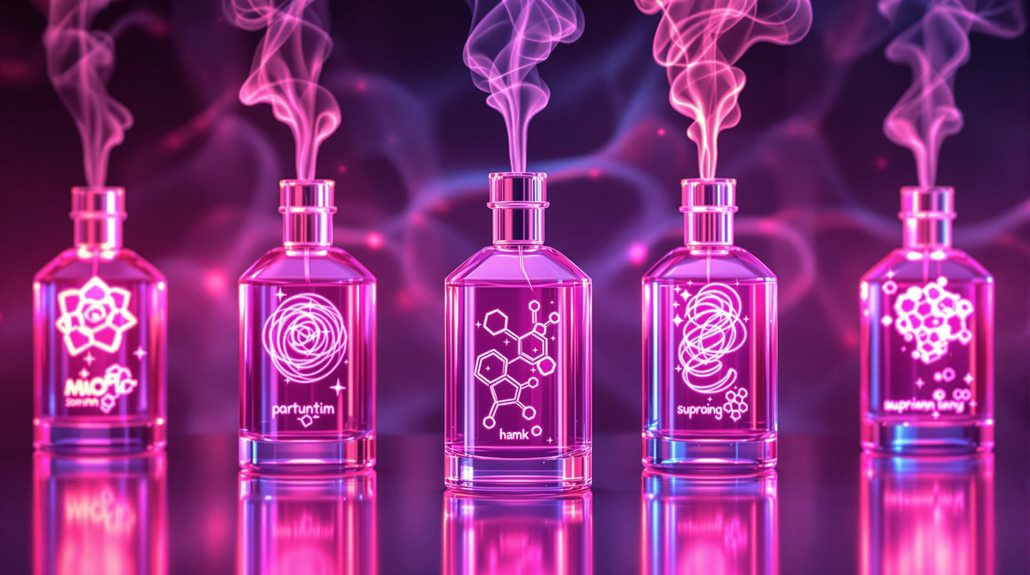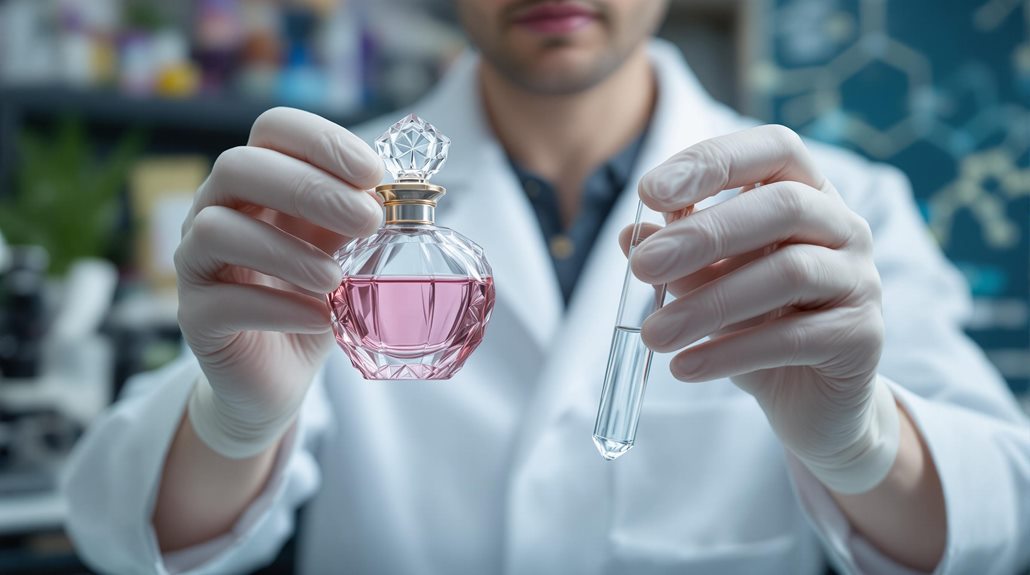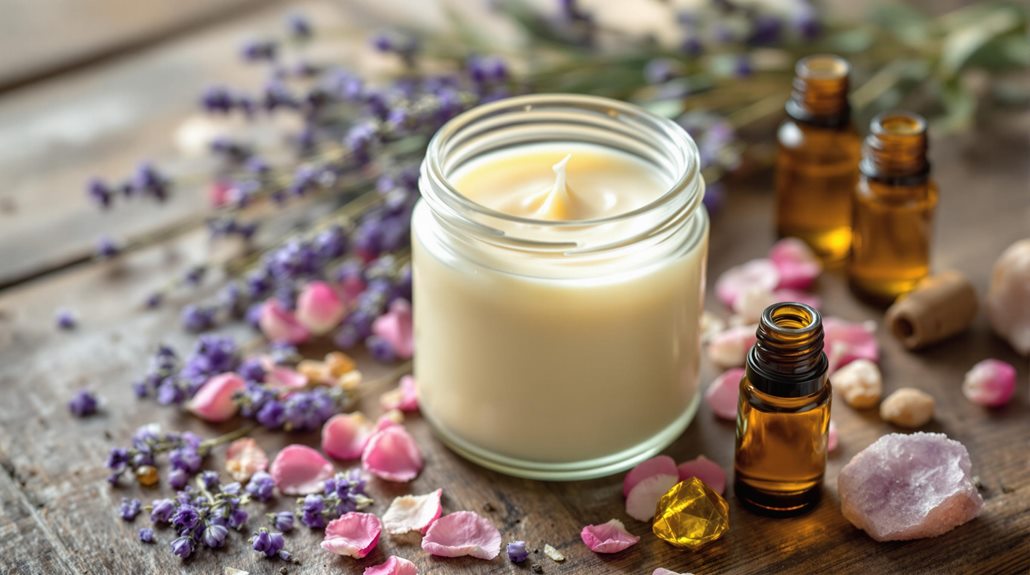The Science Behind Pheromone Perfume: What It Does and How It Works

Pheromone perfumes contain synthetic versions of chemicals found in human sweat and secretions, mixed with essential oils and natural musk. While these products claim to elevate your attractiveness by triggering subconscious responses in potential mates, the science doesn't fully support these promises. Unlike other mammals, humans lack a functioning vomeronasal organ to process pheromone signals effectively. You'll find that traditional factors like confidence, grooming, and biological compatibility play a more significant role in attraction than synthetic pheromones. The relationship between human chemistry and attraction goes much deeper than what's inside those enticing bottles.
Understanding Natural Pheromones
In the vast domain of chemical communication, pheromones stand as nature's invisible messengers. These natural pheromones are chemical signals that animals produce to communicate with others of their species, creating a sophisticated form of nonverbal communication that's crucial for survival and reproduction.
When you look across the animal kingdom, you'll find that creatures use pheromones for various essential purposes. Some animals release these compounds to mark their territory, while others produce pheromones to warn their group of approaching danger. Perhaps most famously, many species use sex pheromones to attract potential mates, triggering specific behavioral responses in recipients.
The way animals detect these chemical signals is fascinating - they're equipped with specialized receptors, particularly the vomeronasal organ, which helps them process these subtle chemical messages. While animals clearly use pheromones in their daily lives, the role of human pheromones isn't as straightforward. Scientists continue to debate whether humans produce pheromones and how they might influence our behavior. What we do know is that body odor contains various chemical compounds, but their function as pheromones remains under investigation.
The Chemistry of Attraction
Moving from nature's broad chemical communication system to the specific molecules that spark attraction reveals a fascinating interplay of compounds. When you're exploring how pheromone perfumes actually work, you'll encounter key chemical compounds like androstenone, androstadienone, and androstanol - the building blocks of human pheromones that manufacturers attempt to replicate in synthetic scents.
While natural pheromones play an essential role in animal communication, their function in human attraction is more complex and subtle. You might wonder if these chemical compounds can truly influence behavior when added to perfume. Research shows that synthetic pheromones can affect your mood and perception of others, but the results aren't as dramatic as marketing claims might suggest.
The challenge lies in how your body processes these scents. Unlike other mammals with clear pheromone detection systems, your ability to sense and respond to these chemical signals isn't fully understood. This uncertainty explains why pheromone perfumes deliver inconsistent results. While some studies show modest effects on attraction and behavior, there's limited scientific evidence supporting the effectiveness of commercial pheromone-enhanced fragrances.
Synthetic Pheromones in Perfumes

Synthetic pheromones have altered the perfume industry's approach to attraction, though their effectiveness remains hotly debated. When you're looking at how pheromone perfumes make their way to market, you'll find they contain synthetic versions of chemicals naturally present in human sweat and secretions. These include compounds like androstenone and androstenol, which are often combined with essential oils and natural musk to create an appealing fragrance.
While manufacturers claim these scents will make you more attractive to others, the science isn't quite as straightforward. Your natural scent plays a role in attraction, but synthetic pheromones may not replicate these effects as effectively as advertised. These products are designed to stimulate the vomeronasal organ, potentially triggering unconscious responses in potential mates. However, research shows that the results are often minimal and inconsistent.
You'll want to approach marketing claims with healthy skepticism, as human attraction involves many complex factors beyond chemical signals. While some studies suggest these synthetic compounds can influence mood and desire, the effects aren't as dramatic or reliable as many perfume companies would have you believe.
Human Response to Pheromones
While synthetic pheromones continue to populate the fragrance market, understanding how humans actually respond to these chemical signals remains a complex scientific puzzle. Studies suggest that your response to pheromones might be more subtle and less straightforward than advertisers of pheromone oil would have you believe.
Unlike other mammals, you don't have a functioning vomeronasal organ, which typically processes pheromone signals. While compounds like androstenone might influence your mood or perceived attractiveness, the effects aren't as dramatic as hoping to instantly attract a mate. The human response to pheromones appears to be modest at best, with inconsistent results across different studies.
What you might experience when using pheromone-based products could be largely attributed to the placebo effect. When you believe you're wearing something that enhances your attractiveness, you're likely to feel more confident, which naturally affects how others perceive you. Your attraction to others actually involves multiple factors, including visual appearance, voice, and social setting, rather than relying solely on chemical signals. This makes the role of synthetic pheromones in human attraction far more complex than previously thought.
Marketing Claims Versus Scientific Evidence

Glossy advertisements and bold promises flood the pheromone perfume market, creating a stark contrast between marketing hype and scientific reality. You'll often see claims that products like Pure Instinct can make you more attractive or irresistible to potential partners, but these assertions aren't backed by rigorous research.
When you examine studies from the National Library of Medicine, you'll find limited evidence supporting whether humans respond to synthetic pheromones in perfume really works as advertised. Most scientific studies that have been independently selected for review show inconclusive results about the effectiveness of these products. While manufacturers claim their formulations can influence behavior and attraction, researchers haven't confirmed these effects in controlled settings.
The gap between marketing claims and scientific evidence is substantial. Companies often cite animal studies or small, non-peer-reviewed trials to support their products' effectiveness. However, scientists still debate whether humans even have functioning pheromone receptors like other mammals do. Before investing in pheromone perfumes, you should understand that their marketed benefits largely rely on anecdotal evidence rather than proven scientific facts.
Real-World Application and Results
Testing pheromone perfumes in real-world settings reveals a stark difference between expectations and actual results. When using Pure Instinct, a popular Pheromone Infused Essential Oil, you'll likely find that the Scent makes less impact than advertised. The Eau de formulation's weak sillage means others may not even notice you're wearing it, regardless of the product's Privacy Policy claims about its effectiveness.
Real-world applications have shown:
- Your natural confidence and personal grooming habits make more impact than Instinct Pheromone products
- Mixing pheromone perfumes with regular fragrances doesn't enhance their effectiveness
- Compliments and attention levels remain largely unchanged compared to wearing regular perfumes
- Individual preferences and biological compatibility play a more significant role in attraction than synthetic pheromones
Rather than relying on pheromone products to enhance your attractiveness, focus on wearing scents that elevate your confidence. Research shows that when you feel comfortable and self-assured in your chosen fragrance, you're more likely to create genuine connections. The real secret isn't in the bottle - it's in how the scent makes you feel and carry yourself.
Conclusion
While you'll find countless pheromone perfumes on the market making bold claims about attraction, the science remains complex and somewhat controversial. You won't find a magic love potion, but research suggests synthetic pheromones may influence mood and behavior subtly. When choosing a pheromone product, it's best to maintain realistic expectations and remember that genuine attraction involves many factors beyond scent alone.




